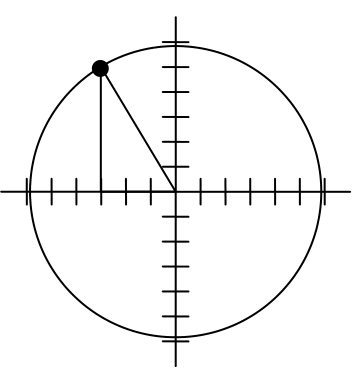Search results
The trigonometric functions (also called the circular functions) are functions of an angle. They relate the angles of a triangle to the lengths of its ... more
The trigonometric functions (also called the circular functions) are functions of an angle. They relate the angles of a triangle to the lengths of its ... more
To rotate the position of the character, we can imagine it as a point on a circle, and we will change the angle of the point by 20 degrees. To do so, we first need to find the radius of this circle and the original angle.
Drawing a right triangle inside the circle, we can find the radius using the Pythagorean Theorem:

To find the angle, we need to decide first if we are going to find the acute angle of the triangle, the reference angle, or if we are going to find the angle measured in standard position. While either approach will work, in this case we will do the latter. By applying the cosine function and using our given information we get
While there are two angles that have this cosine value, the angle of 120.964 degrees is in the second quadrant as desired, so it is the angle we were looking for.
Rotating the point clockwise by 20 degrees, the angle of the point will decrease to 100.964 degrees. We can then evaluate the coordinates of the rotated point
For x axis:
For y axis:
The coordinates of the character on the rotated map will be (-1.109, 5.725)
Reference : PreCalculus: An Investigation of Functions,Edition 1.4 © 2014 David Lippman and Melonie Rasmussen
http://www.opentextbookstore.com/precalc/
Creative Commons License : http://creativecommons.org/licenses/by-sa/3.0/us/
The trigonometric functions (also called the circular functions) are functions of an angle. They relate the angles of a triangle to the lengths of its ... more
A right triangle (American English) or right-angled triangle (British English) is a triangle in which one angle is a right angle (that is, a 90-degree ... more
Stewart’s theorem yields a relation between the length of the sides of the triangle and the length of a cevian of the triangle. A cevian is any line ... more
Trigonometric identities are equalities that involve trigonometric functions and are true for every single value of the occurring variables. Geometrically, ... more
Trigonometric identities are equalities that involve trigonometric functions and are true for every single value of the occurring variables. Geometrically, ... more
Trigonometric identities are equalities that involve trigonometric functions and are true for every single value of the occurring variables. Geometrically, ... more
Trigonometric identities are equalities that involve trigonometric functions and are true for every single value of the occurring variables. Geometrically, ... more
Trigonometric identities are equalities that involve trigonometric functions and are true for every single value of the occurring variables. Geometrically, ... more
Trigonometric identities are equalities that involve trigonometric functions and are true for every single value of the occurring variables. Geometrically, ... more
Trigonometric identities are equalities that involve trigonometric functions and are true for every single value of the occurring variables. Geometrically, ... more
Trigonometric identities are equalities that involve trigonometric functions and are true for every single value of the occurring variables. Geometrically, ... more
Trigonometric identities are equalities that involve trigonometric functions and are true for every single value of the occurring variables. Geometrically, ... more
A triangle is a polygon with three edges and three vertices. In a scalene triangle, all sides are unequal and equivalently all angles are unequal. The area ... more
rigonometric identities are equalities that involve trigonometric functions and are true for every single value of the occurring variables. Geometrically, ... more
rigonometric identities are equalities that involve trigonometric functions and are true for every single value of the occurring variables. Geometrically, ... more
Trigonometric identities are equalities that involve trigonometric functions and are true for every single value of the occurring variables. Geometrically, ... more
Trigonometric identities are equalities that involve trigonometric functions and are true for every single value of the occurring variables. Geometrically, ... more
Calculates the Tangent value of angle θ(in degrees). The tangent of an angle is the ratio of the length of the opposite side to an acute angle of a right ... more
Morley’s trisector theorem states that in any triangle, the three points of intersection of the adjacent angle trisectors form an equilateral ... more
The second moment of area, also known as moment of inertia of plane area, area moment of inertia, polar moment of area or second area moment, is a ... more
The law of cosines relates the cosine of an angle to the opposite side of an arbitrary triangle and the length of the triangle’s sides.
The law
... more
Morley’s trisector theorem states that in any triangle, the three points of intersection of the adjacent angle trisectors form an equilateral triangle, ... more
A quadrilateral is a polygon with four sides (or edges) and four vertices or corners. The interior angles of a simple (and planar) quadrilateral add up to ... more
In Euclidean geometry, an orthodiagonal quadrilateral is a quadrilateral in which the diagonals cross at right angles. It is a four-sided figure in which ... more
A quadrilateral is a polygon with four sides (or edges) and four vertices or corners. An orthodiagonal quadrilateral is a quadrilateral in which the ... more
A quadrilateral is a polygon with four sides (or edges) and four vertices or corners. An orthodiagonal quadrilateral is a quadrilateral in which the ... more
...can't find what you're looking for?
Create a new formula
In a video game design, a map shows the location of other characters relative to the player, who is situated at the origin, and the direction they are facing. A character currently shows on the map at coordinates (-3, 5). If the player rotates counterclockwise by 20 degrees, then the objects in the map will correspondingly rotate 20 degrees clockwise. Find the new coordinates of the character.